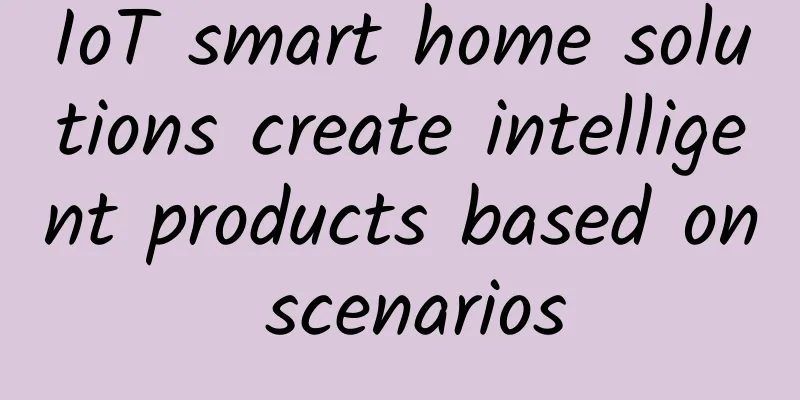IoT smart home solutions create intelligent products based on scenarios

|
"Connected World: Smart Homes Are Key to Future IoT Growth" states that by the end of this year, nearly 20 billion IoT and connected devices will be deployed worldwide, and another 10 billion will be added in the next four years. Enterprises have been the key market for IoT use in recent years, but long-term forecasts show that smart homes are likely to become the main driver of growth in connected and IoT device deployments in the 2020s, with the number of connections reaching 50 billion. Smart home is based on residential functions and new generation information technologies such as the Internet of Things, cloud computing, mobile Internet and big data. It realizes various perception and control scenarios related to family life through automated intelligent systems. The scale of my country's smart home market will show a trend of rapid growth in the next few years. According to the forecast of relevant research institutions, the scale of my country's smart home market will reach US$22.7 billion in 2018. This huge "cake" has become the focus of attention of all parties in the industry.
Poor user experience has become a core pain point in the smart home field As consumers' demands for convenience, safety, and comfort continue to increase, traditional home appliance manufacturers, Internet giants and other companies have entered the smart home market from different angles and made extensive layouts. At present, due to the popularity of WiFi networks in home environments, smart home devices mainly use short-range communication technologies such as WiFi to achieve interconnection. The main problems are as follows: 1. Complex network configuration and poor user experience: Using WiFi solutions to connect devices requires relatively complex network configuration to connect smart devices, resulting in poor user experience and low device networking rate. Smart home companies are in urgent need of configuration-free network solutions; 2. Unreliable network connection: In indoor environments, walls can significantly attenuate WiFi and other signals, so that some home smart devices such as kitchen appliances in blind spots may not work properly due to weak network signals; 3. Not always online: With short-distance communication technologies such as WiFi, smart devices cannot be connected to the Internet all the time. When the WiFi device at home is powered off or fails, the device will be offline, unable to provide intelligent services to users, and it is not convenient to manage the device throughout its life cycle; 4. Devices from different brands cannot be interconnected: Users usually purchase more than one brand, but manufacturers have their own systems. The transmission protocols used by various products are not unified, resulting in the inability of devices to work together and the fragmentation of smart home scenarios. Smart home solutions based on NB-IoT/eMTC effectively solve the above problems Based on the above problems, LPWA technology has gradually entered the smart home market. According to relevant institutions, by 2025, the total number of domestic networked white appliances will exceed 340 million, of which LPWA technology will be used for more than 105 million connections, with a penetration rate of 30%. The smart home solution based on NB-IoT/eMTC has simple network configuration, always-on devices, supports intercommunication and collaboration between devices, and provides customers with cloud-based smart home services. At the same time, the solution can provide enterprises with one-stop services such as remote device management, data collection and data analysis. The basic communication kit (SDK) deployed on the terminal side provides a packaged standard interface and two data channels based on IP and non-IP for enterprises, facilitating two-way communication between smart home devices and the cloud. The platform side provides enterprises with services such as remote equipment management, data collection and analysis, and can be connected to the enterprise's proprietary business platform to facilitate the expansion of application services. The main advantages of smart home solutions based on NB-IoT/eMTC are as follows: 1. More reliable network transmission: Based on the NB-IoT network, it can provide more reliable network transmission services for smart home devices. At the same time, the solution also optimizes the transmission protocol based on network characteristics, which can improve transmission efficiency and bring users a better network service experience; 2. Smarter user experience: Smart home networking no longer requires user configuration, and different smart home devices can be linked together. For example, when a smart thermometer detects that the indoor temperature is too high, it will automatically start the smart air conditioner, giving users a smarter user experience; 3. More complete life cycle management: Device networking based on NB-IoT can make smart home devices "always online", making it easier for smart home companies to manage the entire life cycle of devices from factory to scrapping; 4. Higher data operation value: Unified planning, management and control of smart home devices, realize interconnection between devices of different brands, and provide smarter life services. At the same time, through data collection and data analysis, the integrated analysis of different devices and application data can be realized, which can help enterprises to maximize the value of data operation; 5. Lower development costs: Through deep integration of SDK and communication modules or communication chips, it is compatible with different communication modules or chips, provides a unified interface for terminal applications, simplifies the development workload of smart home companies, and allows them to focus only on upper-level application development without having to worry about the complex underlying communication technology. Based on the above solution, there are currently the following application scenarios: Scenario 1: Smart home appliances Applied to smart home appliances with low data transmission volume, such as smart refrigerators and smart air conditioners, remote control and data collection of devices can be achieved through NB-IoT/eMTC networks. Taking smart air conditioners as an example, users can remotely turn on the air conditioner at home through a mobile phone APP and check the operation of the air conditioner in real time, so that they can directly enjoy a comfortable environment when they return home; Scenario 2: Home Security Smart security devices installed at doors and windows can be connected to the Internet through NB-IoT/eMTC networks, and immediately send alarm information to users when outsiders intrude. Similarly, it can be extended to areas such as flammable gas leakage and kitchen and bathroom water leakage. For example, once open flames and smoke are detected, an alarm can be immediately sent to the user, and the fire extinguishing device at home can be activated at the same time. Outlook: Creating scenario-based intelligent products and services The smart home market has great potential for future development. With the construction of mobile Internet of Things and the maturity of the industrial chain, smart home solutions based on NB-IoT/eMTC will gradually play their unique advantages. Through a unified transmission protocol, they will break the connection barriers between different devices, making it easier for smart home manufacturers to create scenario-based intelligent products and services, and gradually establish industry data models to more deeply tap the value of massive user data. At present, the upstream and downstream of the smart home industry chain include basic operators represented by China Mobile, smart home equipment providers, module manufacturers, chip manufacturers, etc. |
<<: Discussion on SD-WAN development: SD-WAN combined with blockchain technology
>>: Three steps to converge cloud and edge computing for IoT
Recommend
HTTPS already protects half of all web traffic
Implementing HTTPS transmission has many benefits...
Research report points out: By 2027, the 5G service market will exceed US$250.3 billion
Recently, Acumen Research and Consulting, a globa...
Sketch of China's Government Cloud Industry in 2017
[[188315]] [51CTO.com original article] In the ne...
ColoCrossing: $35/month-E3-1240/16GB/1TB HDD or 240G SSD/40TB/8 data centers
ColoCrossing recently released several E3 special...
The battle between 4G+ and all-network service triggered by mysterious letter
Recently, a local company of a certain operator s...
Synchronous vs. Asynchronous Data Transfer: Which is Better?
In any organization, the network infrastructure h...
Network management benefits! Several difficult problems and solutions for LAN
As a qualified network administrator, I believe t...
A brief history of the development of the iSCSI storage protocol
iSCSI stands for Internet Small Computer System I...
Lend me a pair of "smart eyes" and come to Fuzhou to see the "chemical reaction" of smart cameras and multiple application scenarios!
[51CTO.com original article] On March 21, Huawei ...
The speed of light leads the future: Hubei Sports Vocational College upgrades its all-optical network
As a sports vocational college integrating sports...
Stay at home and have fun during the Spring Festival without worrying about WiFi.
Many of my friends stayed at home during the Spri...
Yecao Cloud New Year Special Offer, Hong Kong VPS Annual Payment 36% Off, Starting from 136 Yuan in the First Year
Sharing some information about Chinese VPS mercha...
The rewards and risks facing retailers in a 5G world
The rollout of 5G is expected to have a significa...
Cloud Gateway for Home Computing Networks
Author: Tian Yang, Unit: China Mobile Smart Home ...
IDC survey: Only 9% of enterprises plan to use 5G for IoT deployment
5G promises to be ten times faster than existing ...









